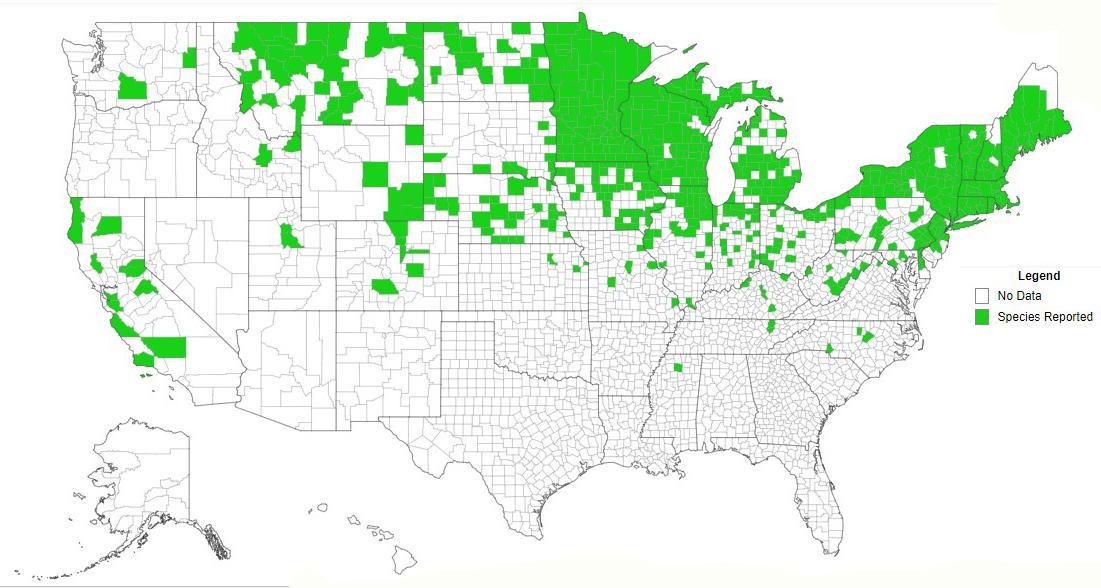European buckthorn, as the name suggests, is a native of Europe. And as is the case with many non-native species that are now considered invasive, it was introduced here as an ornamental plant, perhaps as early as the late 1700s. In the 1900s, it was planted widely to form living fence rows and for wildlife habitat. Since then, it has spread aggressively into a variety of environments. The plant’s current infestation is concentrated throughout the northeast and the upper Midwest states.
It is less well known in Maryland than some of the other invasive plants species that we’ve highlighted in this feature. Currently, it is only found in Montgomery and Baltimore counties. However, neighboring states have more widespread instances. It’s reported in two of Delaware’s three counties, in several West Virginia counties along the Appalachian Mountains, and throughout southeastern Pennsylvania. See the distribution map below.

What is it?
European buckthorn (Rhamnus cathartica) is also called Common buckthorn, Hart’s thorn, or European waythorn. It is a multi-stemmed shrub or occasionally a single stemmed tree that can grow up to 25 feet tall. The name “buckthorn” comes from terminal spines found at the end of its twigs. This perennial plant can tolerate a wide variety of soil types, from well-drained sand to clay. It is found in lightly-shaded areas, but can tolerate full shade. It often invades upland areas, such as wooded margins, areas where trees have fallen, and open oak woodlands. In some states, it has invaded grasslands, lake and stream edges, as well as disturbed sites such as urban landscapes and roadsides.
How does it spread?
This invasive plant spreads widely through seed dispersal. Its flowers appear during late spring (May-June), and its berries ripen during August and September. The berries may stay attached to the plant throughout the winter. These berries are consumed by birds and small mammals and have an laxative effect, leading to the rapid excretion of the seeds inside the berries. Berries that remain fall directly beneath the plant, contributing to a dense concentration of seedlings beneath the parent. The seeds can stay viable in the soil for up to five years. European buckthorn also spreads through stump sprouting.
How can I identify it?
European buckthorn has small, oval-shaped leaves with small, serrated teeth. They may be opposite or alternating on the same stem. The leaves are dull or dark green with a lighter underside. The flowers are small and yellowish, appear in clusters along the stem or in the spaces between the stem and the leaf. Berries are small (5-6 mm) and range from dark purple to black. The plant also has a distinctive yellow sapwood. See the image gallery below.
How can I control it?
European buckthorn seedlings that are less than three feet tall can usually be pulled by hand. Larger plants can be removed with a tool called a weed wrench, as long as care is taken to minimize soil disturbance to reduce the chance of re-sprouting or of additional infestation from other invasive plants. It can also be controlled with foliar, stem injection, basal bark, and cut-stem applications of herbicides.
For more information:
Learn more about European buckthorn:
Invasive Plants in Pennsylvania: Common Buckthorn - PA Dept. of Conservation & Natural Resources
Common or European Buckthorn—Minnesota Dept. of Agriculture
Common Buckthorn—New York Invasive Species Information
 English
English العربية
العربية Български
Български 简体中文
简体中文 繁體中文
繁體中文 Hrvatski
Hrvatski Čeština
Čeština Dansk
Dansk Nederlands
Nederlands Suomi
Suomi Français
Français Deutsch
Deutsch Ελληνικά
Ελληνικά हिन्दी
हिन्दी Italiano
Italiano 日本語
日本語 한국어
한국어 Norsk bokmål
Norsk bokmål Polski
Polski Português
Português Română
Română Русский
Русский Español
Español Svenska
Svenska Català
Català Filipino
Filipino עִבְרִית
עִבְרִית Bahasa Indonesia
Bahasa Indonesia Latviešu valoda
Latviešu valoda Lietuvių kalba
Lietuvių kalba Српски језик
Српски језик Slovenčina
Slovenčina Slovenščina
Slovenščina Українська
Українська Tiếng Việt
Tiếng Việt Shqip
Shqip Eesti
Eesti Galego
Galego Magyar
Magyar Maltese
Maltese ไทย
ไทย Türkçe
Türkçe فارسی
فارسی Afrikaans
Afrikaans Bahasa Melayu
Bahasa Melayu Kiswahili
Kiswahili Gaeilge
Gaeilge Cymraeg
Cymraeg Беларуская мова
Беларуская мова Íslenska
Íslenska Македонски јазик
Македонски јазик יידיש
יידיש Հայերեն
Հայերեն Azərbaycan dili
Azərbaycan dili Euskara
Euskara ქართული
ქართული Kreyol ayisyen
Kreyol ayisyen اردو
اردو বাংলা
বাংলা Bosanski
Bosanski Cebuano
Cebuano Esperanto
Esperanto ગુજરાતી
ગુજરાતી Harshen Hausa
Harshen Hausa Hmong
Hmong Igbo
Igbo Basa Jawa
Basa Jawa ಕನ್ನಡ
ಕನ್ನಡ ភាសាខ្មែរ
ភាសាខ្មែរ ພາສາລາວ
ພາສາລາວ Latin
Latin Te Reo Māori
Te Reo Māori मराठी
मराठी Монгол
Монгол नेपाली
नेपाली ਪੰਜਾਬੀ
ਪੰਜਾਬੀ Afsoomaali
Afsoomaali தமிழ்
தமிழ் తెలుగు
తెలుగు Yorùbá
Yorùbá Zulu
Zulu ဗမာစာ
ဗမာစာ Chichewa
Chichewa Қазақ тілі
Қазақ тілі Malagasy
Malagasy മലയാളം
മലയാളം සිංහල
සිංහල Sesotho
Sesotho Basa Sunda
Basa Sunda Тоҷикӣ
Тоҷикӣ O‘zbekcha
O‘zbekcha አማርኛ
አማርኛ Corsu
Corsu Ōlelo Hawaiʻi
Ōlelo Hawaiʻi كوردی
كوردی Кыргызча
Кыргызча Lëtzebuergesch
Lëtzebuergesch پښتو
پښتو Samoan
Samoan Gàidhlig
Gàidhlig Shona
Shona سنڌي
سنڌي Frysk
Frysk isiXhosa
isiXhosa